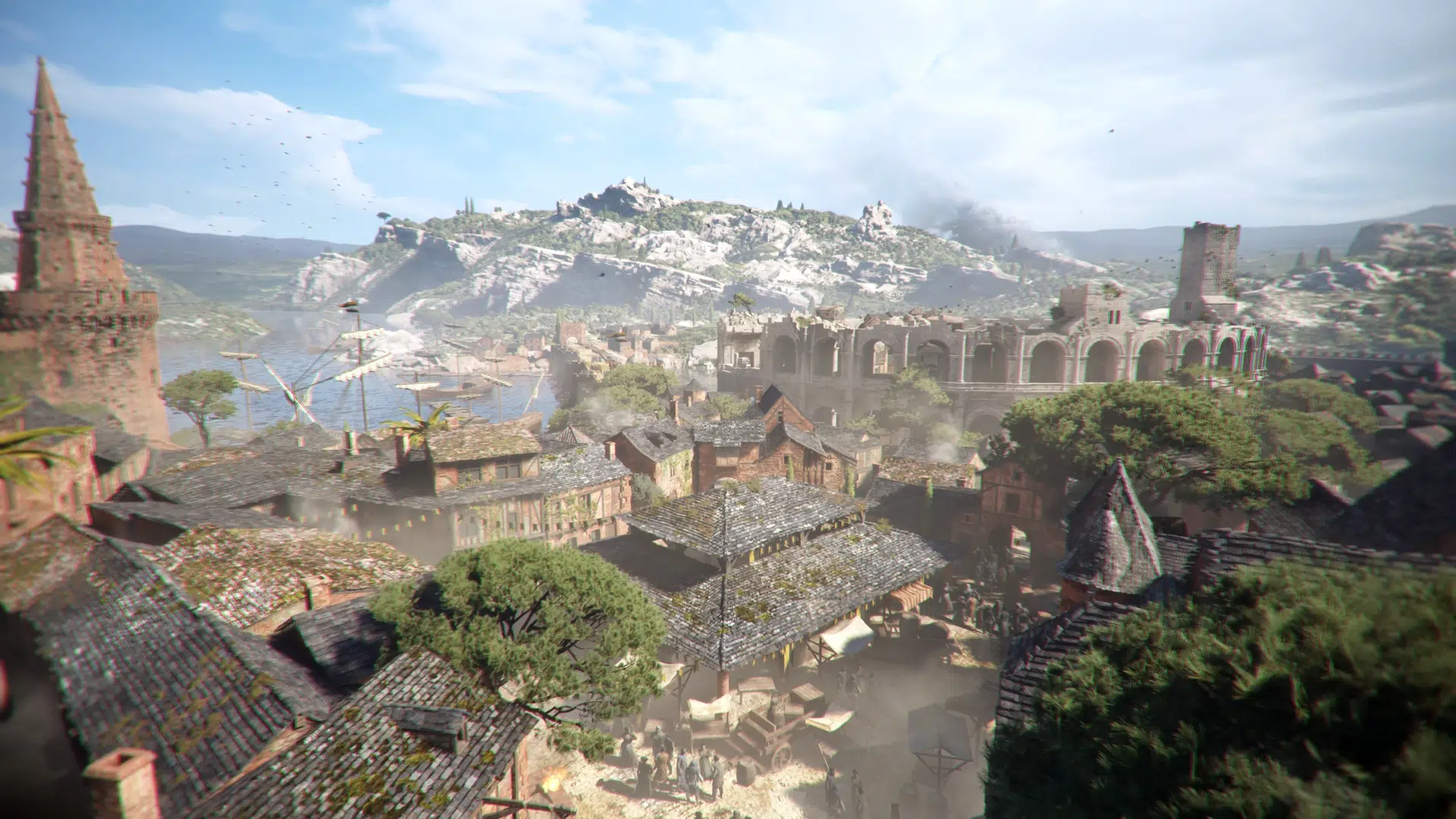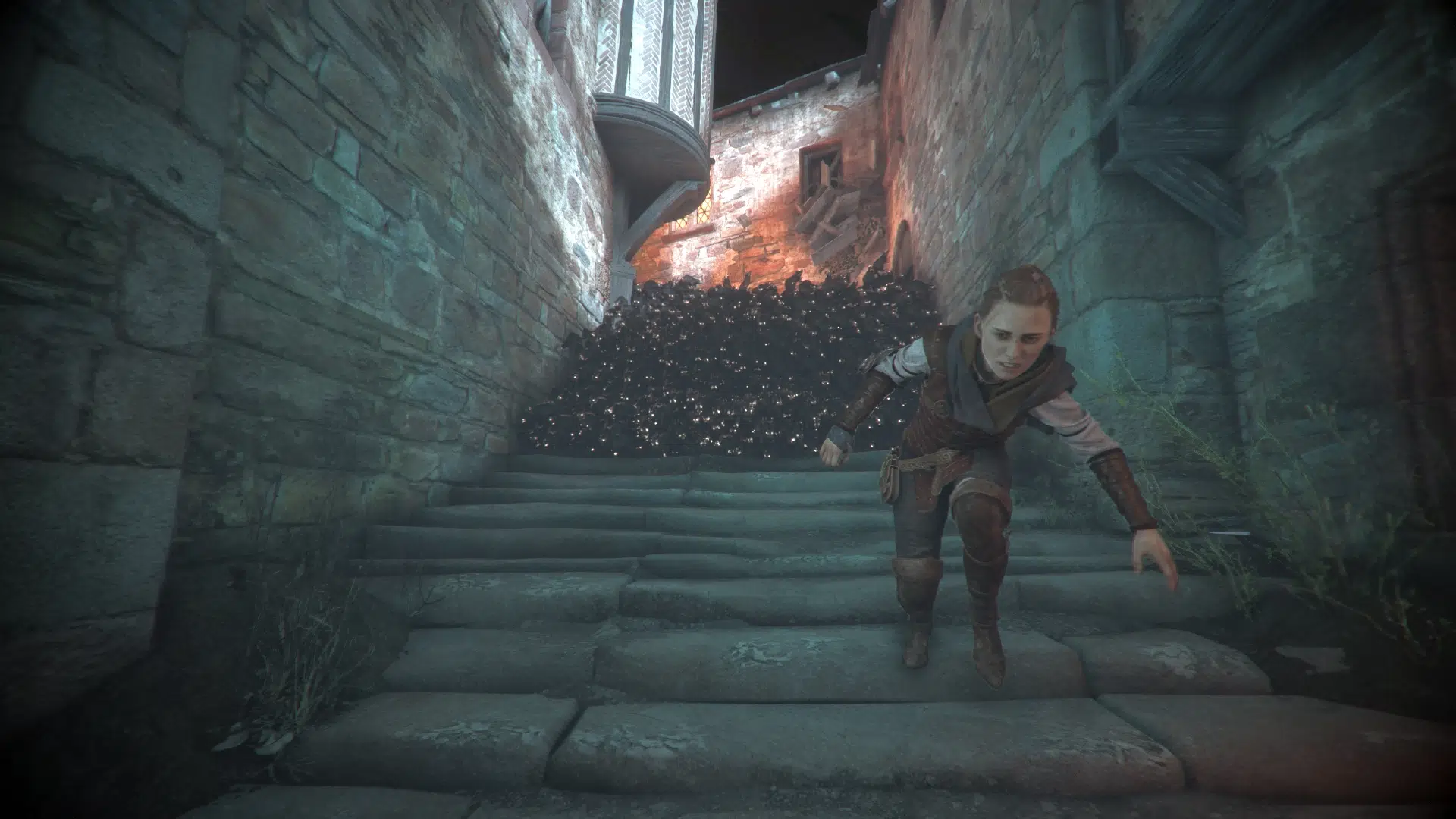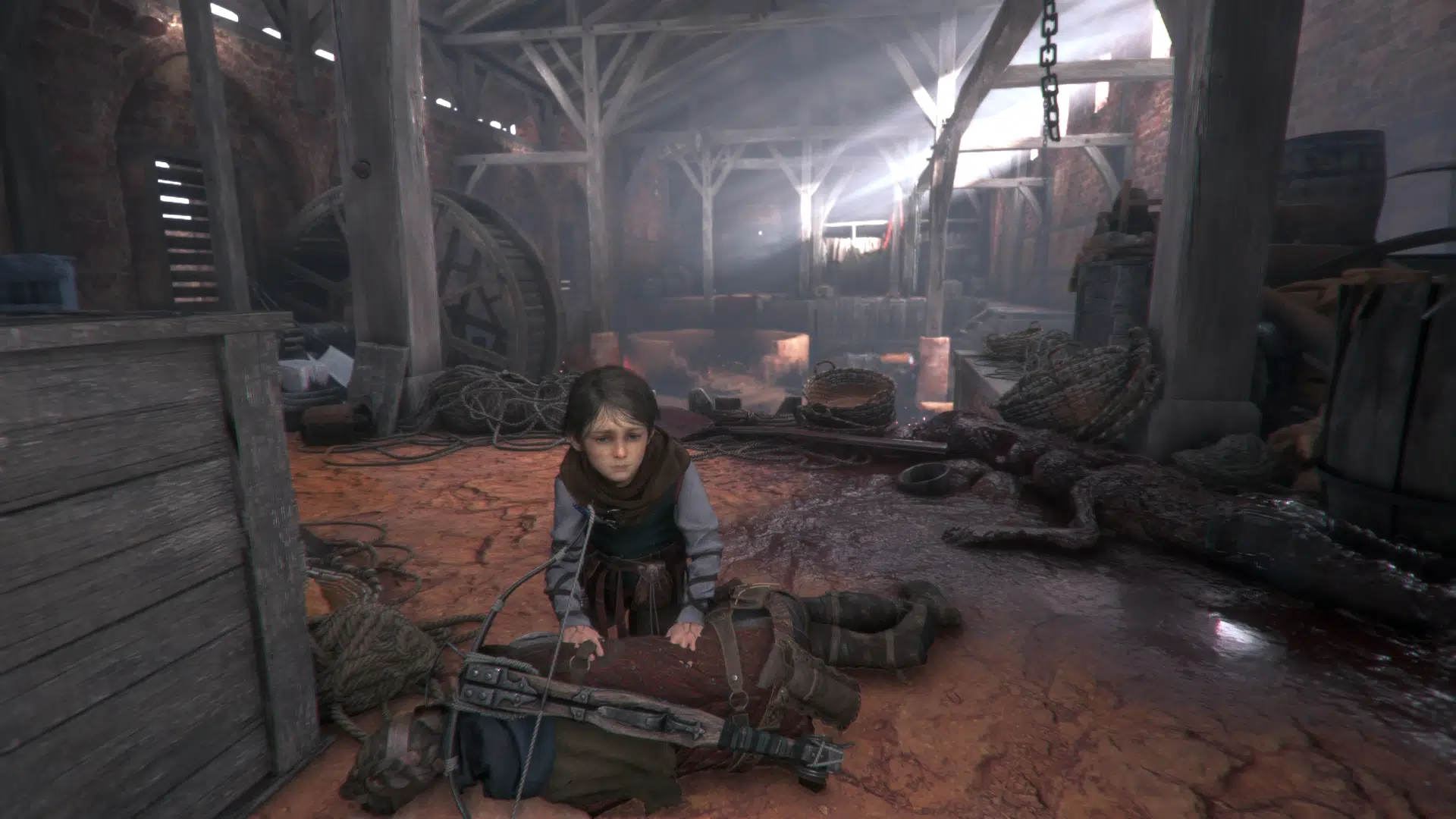Asobo Studio seems to be hitting their stride, with 2019’s A Plague Tale: Innocence and 2020’s Microsoft Flight Simulator showing strong performances both critically and commercially. Now, A Plague Tale: Requiem is upon us, just in time for the Halloween season. Is this a thrilling continuation and refinement of the concepts seen in Innocence, or just more of the same? Find out in our A Plague Tale Requiem review.
A New Land
A Plague Tale: Requiem takes place about six months after the events of Innocence, in France during the year 1349. Amicia, a 16-year-old girl, accompanies her younger brother Hugo, their alchemist mother Beatrice, and her apprentice Lucas. The four of them have been on the road for some time, moving to the Southern France region in an attempt to have a fresh start in a new land. Of course, devastation is never far behind the de Rune family, and in short order they are on the run again, a horde of rats close behind their every move.

While this story does continue where the first left off, playing through Innocence is not necessary to enjoy Requiem. All you need to know, which the game explains, is that Hugo was born with something called the Prima Macula in his blood, a supernatural evil that allows him to somehow commune with rats and influence how they behave. A secret order of alchemists, rather uncreatively dubbed The Order, wants to study Hugo much like how they have studied past carriers of the Macula. Being that this takes place during Medieval times, the church naturally wants in on a piece of the action, so there are at least three different forces coming for the de Rune family. It all makes for an exciting, harrowing adventure that is entertaining throughout the entire 18-22 hour playtime.
Requiem includes a multi-level system whereby Amicia can earn passive skills. She can earn experience in three different areas: Prudence, Aggressive (sic), and Opportunism. Each track has four different skills to unlock, and they are acquired based on how the player behaves. Taking a more aggressive tactic against enemies will unlock more lethal combat options, while opting to distract enemies and sneak by them will offer up quicker actions or a chance to save on resources when crafting. At least, that’s how the game says this system works. In practice, I often found my actions didn’t line up with the experience earned. In one instance, for example, Hugo commented on how many people I killed in an area, for which I received a ton of Opportunism experience. I guess the game decided I was an opportunistic killer! There are also tools and pieces that can be found to upgrade Amicia’s equipment, though upgrade resources are extremely scarce and must be intentionally hunted for, even on the Normal difficulty. It’s a little too grindy to get to some of the better upgrades.

Absurd Rat Count
A custom engine built by Asobo Studio runs on the PS5 quite smoothly, capable of rendering an awe-inspiring 300,000 individual rats compared to the last game’s now paltry 5,000. Most if not all on-screen rats are fully simulated – you can track one with your own eyes and watch it perform various animations as it either moves towards or away from a light source, or rushes towards soon-to-be-dead prey in the dark. While ray tracing has been reserved solely for the PC version of the game, the lighting in Requiem is still pleasingly realistic, something that is important in a game where light is one of your major forms of defense against an otherworldly horde of sewer dwellers. There are no graphics/performance mode toggles, but then the game runs very well no matter what’s happening on-screen. The previous generation of consoles has been left behind this time, a decision Asobo Studio may have made in order to get that rat count up. The PS5’s SSD allows for moderate loading times, though they do feel a little lengthy at times. Some of the game’s locations are very large, though, something this series hasn’t seen to this scale before, so a bit of an extra wait is worth it.
A photo mode has also been included, and it has all the standard sliders and filter options you’re probably used to seeing in other games. What’s more, it can be invoked at any time during the game’s running, even during cutscenes. This can result in some amazing in-game photography options, something that helped during this review to help and capture some of the adventure’s more memorable moments. The custom engine Asobo Studio has built is a graphical powerhouse, perhaps assisted by Quixel’s Megascans for convincingly realistic landscapes. Some more colorful locations such as La Cuna island are beautifully rendered, and make for picturesque photos.

Feel the Conversation
The DualSense controller is used to great effect in A Plague Tale: Requiem. There’s the usual haptic feedback of vibrations when running around, dropping down, and moving heavy objects. Adaptive triggers are used when pulling out Amicia’s main weapons of a sling and crossbow, and a different kind of tension when throwing pots. One notable use of this is when preparing the sling. You have to hold L2 to hold out the sling, along with holding R2 to actually swing the projectile around in the sling. While most of the time you’ll release as soon as you have a “lock” over your target, occasionally you’ll need to wait for the right time to release. For each time the projectile completes a revolution in the sling, the right trigger makes a clicking noise, forcing it to move slightly even though you currently have it pulled down. This also indicates a release point, because the longer Amicia swings the sling around, the more inaccurate she becomes.
But wait, there’s more! A curious option in Requiem has audio play through the DualSense, but not in the way you’re thinking. Rather than use the built-in speaker, the game channels the voice audio into the DualSense’s haptics vibration system. Thus, while the voice of whomever is speaking is still played out of the console’s main audio channel, the controller also vibrates as a sort of echo of the speaker. Because the vibrations in the DualSense are essentially shaped by a waveform, Asobo Studio used this to allow a different way to “feel” someone speaking. What’s more, the vibrations will change in location depending on where the character is in relation to the player. This all adds up to a deeper sense of immersion, and it’s something that everyone should experience at least once.

A Wealth of Stealth Options
A Plague Tale: Requiem is still a stealth-action game, with a heavy emphasis on the stealth. Amicia is not much older than she was in Innocence, and as such she can still be taken out in a moment’s notice by many of the enemies she encounters. She does obtain a crossbow early on in the adventure, but bolts remain hard to come by. Most players will be better off by observing the enemy’s movement, and waiting for the right time to strike. Avoiding combat at all is also usually an option, though it is a tougher strategy to execute, especially considering how easy the game makes it for you to headshot (and kill) any enemy not wearing a helmet at considerable distance. The game also utilizes a rudimentary checkpoint system which usually involves reaching a door. If you can make it to the door, and the opening animation can play before an enemy hits you, then you’re home free and will have no further threats coming at you from that area. This, combined with obvious invisible walls to lock you into an area, feels a little disjointed from an otherwise excellent stealth-centered game.
One other area that could have used some refinement is in handling Hugo. He’s a companion who occasionally comes in handy to reach doorways that Amicia can’t, owing to his smaller size. His abilities also include a way to see enemies and rats through the walls and floors. But since he can’t use these all the time, he generally just slows you down and forces you to seriously contemplate a path because your mobility is slightly restricted. It can be kind of annoying when you can’t just have Hugo wait around in an area that you know isn’t patrolled by soldiers, but given the context of Amicia wanting so badly to protect her little brother, such a mechanic does make sense. Still, some more autonomy in a kid who has already been through hell and forced to grow up quickly would have been helpful. There are also some other options which open up where you command a companion, and these help to solve a puzzle blocking your progression or take out enemies who are otherwise too tough to take on yourself.
Verdict
A Plague Tale: Requiem is better in seemingly every way than Innocence. The environments are bigger, the story is engaging, there’s more tools at Amicia’s disposal, and even Hugo gets a bit of an upgrade. Having him tag along at almost every juncture can get a little annoying, but then so does a real-life younger brother. Even the DualSense’s inclusion makes sense, and the “speaking” vibration enhancements should be experienced at least once. Overall, whether you played the original or not, you owe it to yourself to check out A Plague Tale: Requiem during this spooky season, and beyond.
Score: 9/10
Pros:
- A solid continuation of Innocence
- Larger, more open levels in a mostly-linear package
- Cool use of DualSense controller haptics
Cons:
- Hugo still not very autonomous
- Skills progression doesn’t quite match actions
- Upgrade resources are a chore to acquire
A Plague Tale: Requiem review code provided by publisher. You can read MP1st’s review and scoring policy right here.

